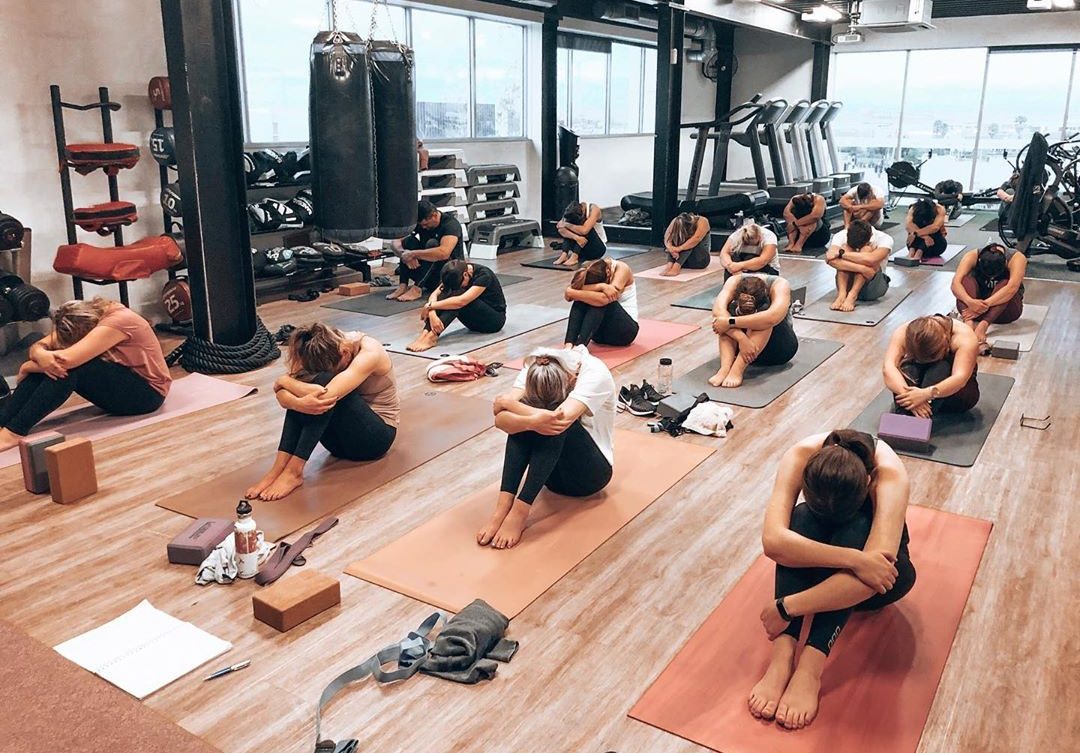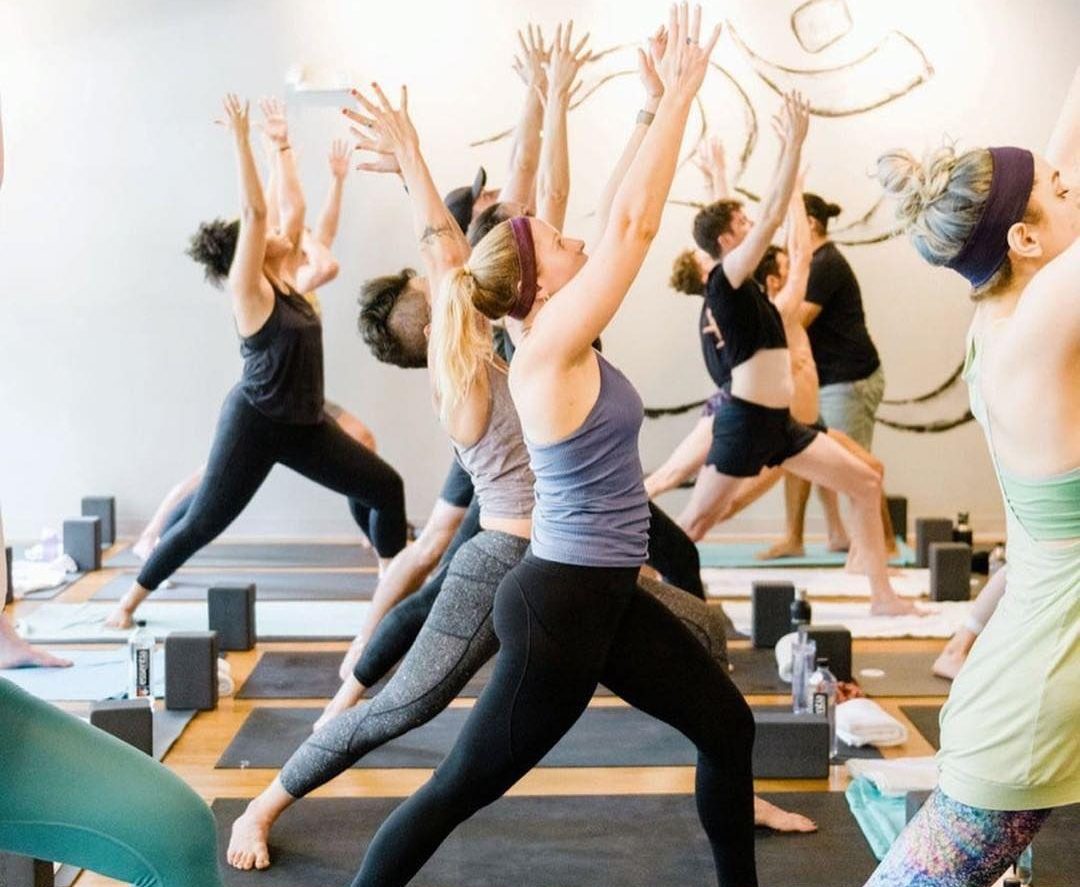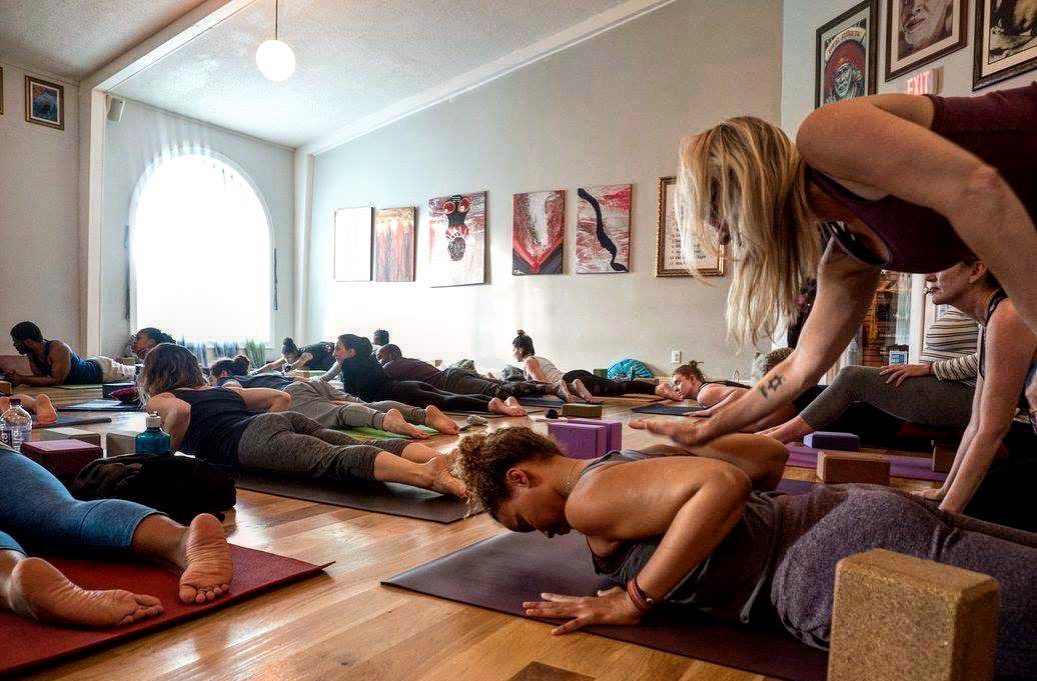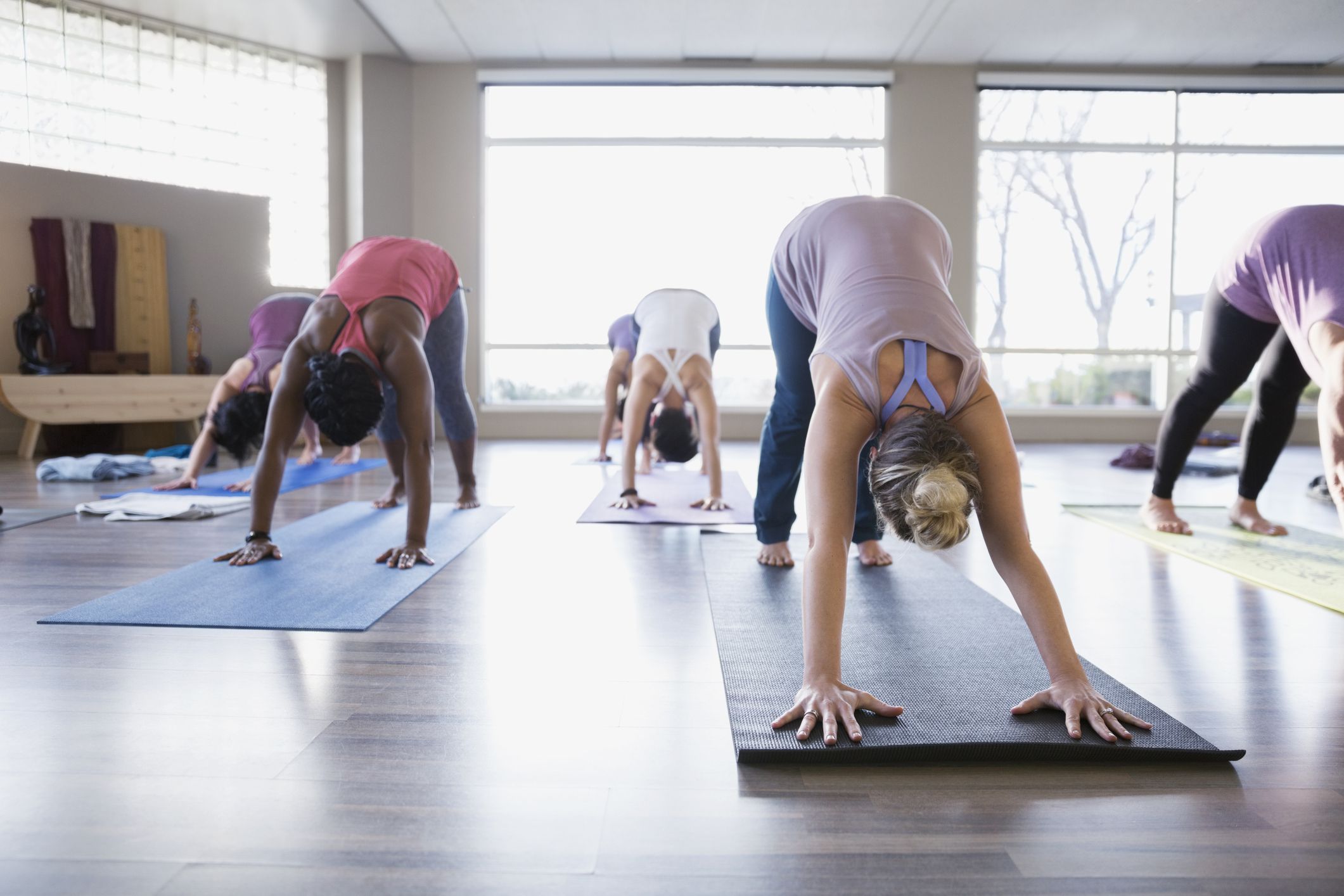First yoga class: the essential tips to enjoy it
Have you been convinced by one of your relatives? You have browsed through the blog and feel ready? Have you been told that it's high time you learned how to relax? Whatever your reasons for taking your first yoga class, this is the beginning of a great adventure! But starting yoga also means getting out of your comfort zone, taking on yourself and sometimes feeling a little anxious. So today I am sharing with you an article that explains everything you need to know about your first yoga class in order to prepare yourself and live this experience in a more serene way. Let's get started!
My first yoga class
I remember my first class very well. It was during an internship focused on "opening the heart". The professor had talked about ayurveda, kriyas, dosha... Everything was both great and difficult. I immediately liked what this yoga teacher had to say. I loved the theoretical part, but also every second of the practice. However, she came to correct me several times, I was incredibly lacking in strength and she offered a balance on my hands that I was totally unable to do. And you know what? I came out of that first class convinced by yoga! Yes, even though it was painful and complicated...
You too will certainly feel very ambivalent at the end of your first yoga class. However, you should know that as time goes by, everything softens. Things become simpler and the benefits of the practice are felt with each session.
So, what do you need to know before you start your first yoga class? Here is my advice!
First yoga class: choosing your style and studio
The first thing to do if you want to take a yoga class near you is probably to find out about nearby studios, their teachers and the style of yoga being practiced. Indeed, there are an infinite number of styles of yoga. Some are very dynamic. Others focus primarily on meditation. Still others allow for deep relaxation with as little movement as possible.
So, if you are looking for a moment of relaxation, you may be lost in a Vinyasa class, where you might get sweaty. Similarly, if you're embarking on a Kundalini yoga class, the spiritual side may surprise you. On the blog, I have written many articles on the different styles of yoga. So I would advise you to take a look at them to avoid saying, "this is not at all what I was expecting! ». It would be a shame to simply abandon your practice because you've knocked on the wrong door...

Preparing for his arrival
In addition, you will probably need to book your course before your arrival. This can be done directly on the teacher's website, by phone or by email. I think it is always best to contact the teacher directly and explain that this is the first time you are doing yoga. This way you can share with him/her the other sports you practice and/or tell him/her what you come for (if you want to move, have fun or relax for example). This way, the teacher will quickly be able to tell you if the style of yoga he teaches is right for you.
Also, if you have a medical condition or if you are pregnant, let the teacher know directly when you make your reservation.
Before your course: what to do and bring?
The first thing to know is that yoga is practiced on an empty stomach. Therefore, it is best to go to your class 2 to 3 hours after a meal. This is because you may feel nauseous while practicing certain postures (especially the twists). In addition, it is considered that energy is more important outside of digestion and therefore ideal to practice. However, if you are afraid of feeling sick, take with you a fruit or snack that you can take with you just in case. You can also eat a healthy snack 1 hour before your class.
For your first yoga class, it is also advisable to take :
- A yoga or fitness mat, if the room does not provide one.
- A bottle of water.
-A sweater and socks for relaxation.
- A small towel, especially if you do Bikram yoga or to avoid slipping.
On the other hand, regarding your yoga outfit, I have already shared many tips in this article and in this one. Nevertheless, for your first yoga class, keep it simple. I advise you to bring leggings or loose pants, a sports bra and a tank top. And if you're a man, opt for shorts or jogging suits.
Ladies, also remember to bring some hair tie-downs. Even if it's relatively short, it can quickly get in the way of your postures. You should also avoid perfume and remove your jewelry before the class begins. Finally, be aware that yoga is practiced barefoot. This allows you to have a better anchorage to the ground, not to slip and to facilitate balance. But if it bothers you, you can keep a pair of thin socks without any problem.
Among your belongings, also take along a set of clothes to regulate your session of course. Finally, know that you can change your clothes on the spot. There are usually separate changing rooms for men and women and you can also store your belongings there. Remember to put your phone in silent mode before the start of the class.
Yoga Classes
That's it! It's time for your first yoga class. Your heart is pounding, your hands are sweaty and you feel like you've forgotten everything. Take a deep breath... You're going to be fine!
For your first session, it is recommended that you arrive 10 minutes before the class starts. This will give you time to chat with the teacher, change your clothes and even go to the bathroom before practice. There is nothing worse than an hour of yoga with the urge to pee!
Upon arrival, some students may already know each other. Don't worry! Over time, you will build relationships as well. Try to locate the teacher so that you can introduce yourself and share a few words with him/her.

A few tips
When you enter the yoga room, you usually have to take off your shoes (but you can keep your socks on). This is mostly done for hygienic reasons. Indeed, it is a way to avoid dirt getting inside, especially in a place where you are going to practice on the floor and lie down on the floor. On the other hand, it is also a sign of politeness and respect often found in Asian culture.
Also, if there are yoga mats on the floor, do not step on them. Many people consider their mat as an extension of their being or an intimate place where they come to recharge their batteries. Therefore, it is frowned upon to walk on it.
It's almost time for class? So, get dressed, bring your water bottle next to your mat, but also your towel, snack or even your sweater for relaxation. Then, sit on one of the mats present or unroll yours at the place indicated by your teacher.
Knowing that this is your first yoga class, the teacher will certainly ask you if you have any pain or injuries. Do not hesitate to be exhaustive, this will allow him to adapt the postures and to better accompany you.
Finally, at the end of your class, you will normally have to :
- Clean your mat with the spray provided by your teacher and put it away.
- Set up your course with the teacher.
- And then go back to the course of your life, more appeased!
What postures do I need to know before my first yoga class?
I've seen some articles that explain "the postures you need to know to be successful in your first yoga class"... To be honest, I think it's completely useless to ask about this. You can come to your first yoga class as a complete beginner, that's perfectly normal. So don't worry, everyone has started that way, even your teacher. During this first class, no one will judge you by your level of practice. That's not really what we do in yoga class. And forget about the idea of "passing your class", because yoga has nothing to do with that...
On the other hand, it is not in one day that you will learn to do the dog upside down without difficulty or that you will be able to remember the sequence of a sun salutation by heart. Again, this is completely normal.
Basically, you don't have to know any posture before your first yoga class. Everything will be explained to you on the spot. Of course, it will probably be more difficult for you than for the other students present (if they have already practiced), but the goal is not to follow them. Just do what you can do today. Yoga is not about success or competition.
So what do you need to do? Personally, I advise you to take this yoga session as a time to relax and listen to your feelings. As much as possible, instead of looking around you, turn inward. If you make a mistake, your teacher will correct you. And he may not even correct you, because it doesn't matter if you started with the left foot instead of the right foot...

End of your first yoga class: what now?
No doubt that yoga seemed to you like something difficult and that this session was a source of stress above all. I was in the same situation as you. And yet, I came out of my first yoga class feeling really good. It is this feeling that will remain with you throughout your classes, not the stress or difficulty.
Yes, yoga can be uncomfortable at times. Some postures can be difficult. And there are days when you don't feel like it as much as others. But in the end, you always come out of it refreshed. So, if you enjoyed this feeling, I advise you to persevere. Even if you've spent an hour feeling like you're fighting your body.
The choice of the teacher: a decisive element to persevere
I also believe that the teacher who accompanied your session is very important for the future. I have had several over the years and each time, my first meeting with my teacher was a real crush. Otherwise, I did not persevere. So, if you are uncomfortable with his teaching, if you don't like what he has to say, let it go and try another yoga session somewhere else. Every yoga teacher is different and it's human to prefer some things to others. You have the right to choose the one you feel comfortable practicing with. This in no way calls into question his or her skills and the quality of his or her work.
For example, a friend once told me that a yoga teacher talked a lot throughout the class, gave a lot of explanations and that this prevented him from concentrating on his practice. For my part, I once attended a class in Spain where the teacher gave almost no explanations and did postures or breathing exercises that I didn't know, all with my eyes closed. I must confess that I felt a bit lost in her class... Nevertheless, this does not mean that there are better or worse teachers. It's just that you have to find the one with whom it will click!
First yoga class: Things to know during the class
Here are some explanations on elements that often come up during a yoga class.
"Om". This mantra is often pronounced at the beginning and/or end of the course. It is sometimes sung three times in a row and the phrase "Shanti Shanti Shanti Shanti" may be added. It is practiced by taking a breath and saying " Om " on the exhalation (for about 1 minute). This mantra can make you feel uncomfortable or even make you laugh during your first yoga class. This way, you don't have to follow the students or the teacher. You can simply listen. However, understanding its meaning will often make you more comfortable with it. Don't hesitate to ask for more information.
Namaste. At the end of the class, everyone is usually in a sitting posture on the mat with their hands placed against their heart. The teacher concludes the session with the word "Namaste" (or simply thank you). Then, each student repeats "Namaste" and sometimes the Namaste gesture is made to the other students present. If you are a little uncomfortable for your first yoga class with this gesture and mantra, you can simply keep your hands palm to palm facing the heart and observe.
Child's posture. This posture will be your favorite for your first yoga session. It will allow you to rest and catch your breath. If there is only one posture to know before your first yoga class, it might be this one. However, your teacher will be able to explain it to you on the day.
Relaxation or Savasana. At the end of the session, everyone lies on their back on their mat, legs and arms stretched out on the floor. It is a moment of calm and silence. Sometimes your teacher will accompany you in a guided relaxation. This moment is very important in a yoga class. It allows you to integrate the benefits of the practice and to rest your mind. So, when you hear "we are going to move on to Savasana (or Shavasana)", you will know that it is time to cover up if necessary and lie down.
The material present. Next to your mat, you will probably find a yoga strap to help you with some stretching and yoga bricks to support the postures. During some sessions, meditation cushions or bolsters can also be used. Your teacher can also make you listen to the sound of a Tibetan bowl, burn incense or Palo Santo. However, the equipment in the room will be quite different if you practice Iyengar yoga or restorative yoga for example.

First yoga class: how does a session take place?
First of all, you will be able to take your place on your mat before the beginning of the class while waiting for the other students. Take a moment to close your eyes, come back to you or simply wait for time to pass... Then, your teacher will certainly share a little word with you to explain the content of the session. He or she will also be able to put on some music.
The yoga sessions are all different depending on the style of yoga and the teacher. With some, you may start with a tailor-made meditation. With others, you can start by standing, sitting or lying down. Just let yourself be guided by the voice of your teacher. He will give you all the indications on what you need to do.
During the class, if you don't understand certain instructions, observe the other students or your teacher to help you. However, if it is really too complicated for you, you can always wave to your teacher to come to you. There is a tendency to whisper during the session to respect other students' practice.
Generally, a yoga class begins with simple stretching postures of the body (especially the back). Then, we continue with more dynamic or difficult sequences. Towards the end of the session, the postures are again slower, sometimes focusing on flexibility. Indeed, as the body is warm, it is ideal to work the muscles in depth. Finally, especially in Hatha Yoga, part of the class can also be devoted to breathing exercises or meditation. All this will be guided by your teacher as well. At the end of the session, you will be led to do a relaxation, lying on your back. A class usually lasts from 1 hour to 1h30.
What do you have to do?
Yoga pays special attention to breathing. Therefore, in each posture, try to pay attention to your breathing, which should be slow and deep. At first, it will probably be difficult to coordinate your movements with the breath. Your teacher may tell you, "when you exhale do this", "when you inhale do that" and you will blend ten times. This is perfectly normal and it took me many months to understand this principle and to be able to apply it. So no pressure, just do your best!
On the other hand, resist the urge to go too far in the postures or to tire yourself unnecessarily. It is normal that your rhythm is slower, that your flexibility is not as good. You are not here to show off your technical prowess or to reach a certain level. Just think about doing yourself some good. So let your day's concerns go away, your mind travels and focus only on how you feel.
This first yoga class may seem strange to you. You'll find a lot of words you don't know, especially in Sanskrit. Don't worry, all this will quickly become a habit. Don't stop at that. Soon you'll become a master of the subject and after all, it's always good to get out of your comfort zone, isn't it?
If your teacher puts you back in the class, don't take it the wrong way. He adjusts all the students to correct them and prevent them from getting hurt or going too far. Also, don't compete with yourself or others. Avoid comparing yourself to those around you. Go back a bit in time to be more comfortable in certain postures. And if you feel like resting, do so.

How often should I practice?
If you are a beginner, you should probably focus on one yoga session a week. Indeed, we often start very motivated at the idea of practicing but in the end, time passes and we forget our good intentions... Having only one class per week is a good way to stick to it. You will then be able to practice at home a little every day with a video for example. You will also be able to do more classes each week if you wish: two is a good average.
It is often considered that 5 minutes of yoga each day is better than 2 hours once in a while. But if you are a beginner, this will probably seem complicated. So do what feels right for you.
You are now perfectly prepared for your first yoga class. Feel free to ask me any questions you may have in the comments section and share your experience with me. Namaste.


